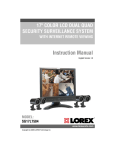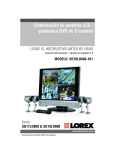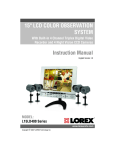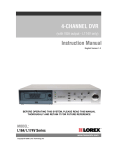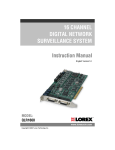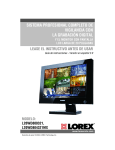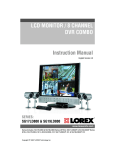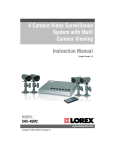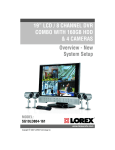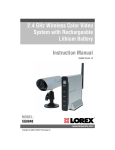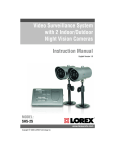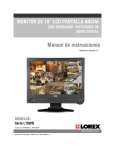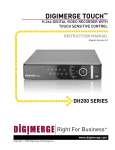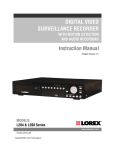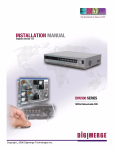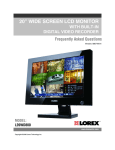Download LOREX Technology L3104 User's Manual
Transcript
4 CHANNEL NETWORKABLE DIGITAL VIDEO RECORDER Instruction Manual English Version 1.0 MODEL: L3104 www.lorexcctv.com Copyright (c) 2006 LOREX Technology Inc. Thank you for purchasing the 4 Channel Network Digital Video Recorder. Lorex is committed to providing our customers with a high quality, reliable security product. The LOREX L3104 Network DVR records in Real Time on 4 Channels with 120 fps recording capability. Images can be easily transferred using the USB flash drive. The system can be viewed and controlled over the internet from a remote location with trouble free access via the Free DDNS Service. To learn more about this 4 Channel Network Digital Video Recorder, and to learn about our complete range of accessory products, please visit our website at: http://www.lorexcctv.com CAUTION RISK OF ELECTRIC SHOCK DO NOT OPEN CAUTION: TO REDUCE THE RISK OF ELECTRIC SHOCK DO NOT REMOVE COVER (OR BACK). NO USER SERVICEABLE PARTS INSIDE. REFER SERVICING TO A QUALIFIED SERVICE PERSONNEL The lightning flash with arrowhead symbol, within an equilateral triangle, is intended to alert the user to the presence of uninsulated “dangerous voltage” within the product’s enclosure that may be of sufficient magnitude to constitute a risk of electric shock to persons. The exclamation point within an equilateral triangle is intended to alert the user to the presence of important operating and maintenance (servicing) instructions in the literature accompanying the appliance. WARNING: TO PREVENT FIRE OR SHOCK HAZARD, DO NOT EXPOSE THIS UNIT TO RAIN OR MOISTURE. CAUTION: TO PREVENT ELECTRIC SHOCK, MATCH WIDE BLADE OF PLUG TO WIDE SLOT, FULLY INSERT. ii Important Safeguards Important Safeguards In addition to the careful attention devoted to quality standards in the manufacture process of your video product, safety is a major factor in the design of every instrument. However, safety is your responsibility too. This sheet lists important information that will help to assure your enjoyment and proper use of the video product and accessory equipment. Please read them carefully before operating and using your video product. Installation 1. Read and Follow Instructions - All the safety and operating instructions should be read before the video product is operated. Follow all operating instructions. 2. Retain Instructions - The safety and operating instructions should be retained for future reference. 3. Heed Warnings - Comply with all warnings on the video product and in the operating instructions. 4. Polarization - Do not defeat the safety purpose of the polarized or grounding-type plug. A polarized plug has two blades with one wider than the other. A grounding type plug has two blades and a third grounding prong. The wide blade or the third prong are provided for your safety. If the provided plug does not fit into your outlet, consult an electrician for replacement of the obsolete outlet 5. .Power Sources - This video product should be operated only from the type of power source indicated on the marking label. If you are not sure of the type of power supply to your location, consult your video dealer or local power company. For video products intended to operate from battery power, or other sources, refer to the operating instructions. 6. Overloading - Do not overload wall outlets of extension cords as this can result in the risk of fire or electric shock. Overloaded AC outlets, extension cords, frayed power cords, damaged or cracked wire insulation, and broken plugs are dangerous. They may result in a shock or fire hazard. Periodically examine the cord, and if its appearance indicates damage or deteriorated insulation, have it replaced by your service technician. 8. Ventilation - Slots and openings in the case are provided for ventilation to ensure reliable operation of the video product and to protect it from overheating. These openings must not be blocked or covered. The openings should never be blocked by placing the video equipment on a bed, sofa, rug, or other similar surface. This video product should never be placed near or over a radiator or heat register. This video product should not be placed in a built-in installation such as a bookcase or rack unless proper ventilation is provided or the video product manufacturer’s instructions have been followed. 9. Attachments - Do not use attachments unless recommended by the video product manufacturer as they may cause a hazard. 10. Water and Moisture - Do not use this video product near water. For example, near a bath tub, wash bowl, kitchen sink or laundry tub, in a wet basement, near a swimming pool and the like. Caution: Maintain electrical safety. Powerline operated equipment or accessories connected to this unit should bear the UL listing mark of CSA certification mark on the accessory itself and should not be modified so as to defeat the safety features. This will help avoid any potential hazard from electrical shock or fire. If in doubt, contact qualified service personnel. 11. Accessories - Do not place this video equipment on an unstable cart, stand, tripod, or table. The video equipment may fall, causing serious damage to the video product. Use this video product only with a cart, stand, tripod, bracket, or table recommended by the manufacturer or sold with the video product. Any mounting of the product should follow the manufacturer’s instructions and use a mounting accessory recommended by the manufacturer. 7. Power-Cord Protection - Power supply cords should be routed so that they are not likely to be walked on or pinched by items placed upon or against them, paying particular attention to cords at plugs, convenience receptacles, and the point where they exit from the video product. iii Important Safeguards Service Use 13. Servicing - Do not attempt to service this video equipment yourself as opening or removing covers may expose you to dangerous voltage or other hazards. Refer all servicing to qualified service personnel. 19. Cleaning - Unplug the video product from the wall outlet before cleaning. Do not use liquid cleaners or aerosol cleaners. Use a damp cloth for cleaning. 14. Conditions Requiring Service - Unplug this video product from the wall outlet and refer servicing to qualified service personnel under the following conditions. A. When the power supply cord or plug is damaged. B. If liquid has been spilled or objects have fallen into the video product. C. If the video product has been exposed to rain or water. D. If the video product does not operate normally by following the operating instructions. Adjust only those controls that are covered by the operating instructions. Improper adjustment of other controls may result in damage and will often require extensive work by a qualified technician to restore the video product to its normal operation. E. If the video product has been dropped or the cabinet has been damaged. F. When the video product exhibits a distinct change in performance. This indicates a need for service. 15. Replacement Parts - When replacement parts are required, have the service technician verify that the replacements used have the same safety characteristics as the original parts. Use of replacements specified by the video product manufacturer can prevent fire, electric shock or other hazards. 16. Safety Check - Upon completion of any service or repairs to this video product, ask the service technician to perform safety checks recommended by the manufacturer to determine that the video product is in safe operating condition. 17. Wall or Ceiling Mounting - The cameras provided with this system should be mounted to a wall or ceiling only as instructed in this guide, using the provided mounting brackets. 18. Heat - The product should be situated away from heat sources such as radiators, heat registers, stoves, or other products (including amplifiers) that produce heat. iv 20. Product and Cart Combination - Video and cart combination should be moved with care. Quick stops, excessive force, and uneven surfaces may cause the video product and car combination to overturn. 21. Object and Liquid Entry - Never push objects for any kind into this video product through openings as they may touch dangerous voltage points or “short-out” parts that could result in a fire or electric shock. Never spill liquid of any kind on the video product. 22. Lightning - For added protection for this video product during a lightning storm, or when it is left unattended and unused for long periods of time, unplug it from the wall outlet and disconnect the antenna or cable system. This will prevent damage to the video product due to lightning and power line surges. General Precautions NOTE This equipment has been certified and found to comply with the limits regulated by FCC, EMC, and LVD. Therefore, it is designated to provide reasonable protection against interference and will not cause interference with other appliance usage. However, it is imperative that the user follows this manuals guidelines to avoid improper usage which may result in damage to the unit, electrical shock and fire hazard injury In order to improve the feature functions and quality of this product, the specifications are subject to change without notice from time to time. FCC CLASS B NOTICE Note: This equipment has been tested and found to comply with the limits for a Class B digital device, pursuant to Part 15 of the FCC Rules. These limits are designed to provide reasonable protection against harmful interference in a residential installation. This equipment generates, uses, and can radiate radio frequency energy and, if not installed and used in accordance with the instruction, may cause harmful interference to radio communications. However, there is no guarantee that interference will not occur in a particular installation. If this equipment does cause harmful interference to radio or television reception (which can be determined by turning the equipment on and off), the user is encouraged to try to correct the interference by one or more of the following measures: z z z z Reorient or relocate the receiving antenna Increase the separation between the equipment and receiver Connect the equipment into an outlet on a circuit different from that to which the receiver is connected Consult the dealer or an experienced radio or television technician for assistance General Precautions 1. All warnings and instructions of this manual should be followed 2. Remove the plug from the outlet before cleaning. Do not use liquid aerosol detergents. Use a water dampened cloth for cleaning 3. Do not use this unit in humid or wet places 4. Keep enough space around the unit for ventilation. Slots and openings in the storage cabinet should not be blocked 5. During lightning storms, or when the unit is not used for a long time, disconnect the power supply, antenna, and cables to protect the unit from electrical surge LOREX TECHNOLOGY INC. http://www.lorexcctv.com v Observation System Features DVR System Features • High quality recording with modified MJPEG compression (5~20Kbyte/frame) • USB port for transferring critical images and firmware upgrade • 120 fps recording speed for Real Time display & recording on 4 channels • Programmable Video Motion Detection • 4 camera inputs (4 BNC) • Pre-alarm recording feature • High quality recording with modified MJPEG compression (5~20Kbyte/frame) • Audio Recording Function is available • Internet / Web Ready – view and control your DVR from anywhere in the world over the internet * • Free DDNS Service included for easy remote internet access * * Broadband Internet connection and Router required for Remote viewing over the internet DVR Manager Software • View and Record from your PC - Connect to your DVR over your Network • Minimum System Requirements: Windows XP, Pentium 4 processor with 256MB RAM vi Table of Contents Table of Contents Getting Started .......................................................................................... 9 L3104 - Front ..................................................................................... 10-12 L3104 - Back ........................................................................................... 13 Installing the Hard Drive ..................................................................... 14-15 Starting the DVR - Self Test Screens ..................................................... 16 Starting the DVR - QUAD Display ........................................................... 17 Main Menu Control .................................................................................. 18 Main Menu Tree ...................................................................................... 19 Playback Menu .................................................................................. 20-21 Playback Menu Tree .................................................................................................................. 20 Go To First ................................................................................................................................. 21 Go To Last ................................................................................................................................. 21 Time & Date ............................................................................................................................... 21 Event Search ............................................................................................................................. 22 Setup Menu ............................................................................................. 23 Setup Menu Tree ....................................................................................................................... 23 Record Setup .......................................................................................... 26 Alarm Record Setup .................................................................................................................. 26 Motion Record Setup ................................................................................................................. 26 Schedule Record Setup ............................................................................................................. 27 Normal Record Setup ................................................................................................................ 28 Overwrite Setup ......................................................................................................................... 29 Voice Setup ............................................................................................. 29 Camera Setup ......................................................................................... 30 Camera Titles ............................................................................................................................ 30 Brightness .................................................................................................................................. 30 Contrast ..................................................................................................................................... 30 Alarm Setup ............................................................................................ 31 Alarm ON/OFF ........................................................................................................................... 31 Alarm Attributes ......................................................................................................................... 31 Video Loss Alarm ...................................................................................................................... 31 Alarm Hold ................................................................................................................................. 31 Buzzer Out.................................................................................................................................. 31 Display Setup .......................................................................................... 32 Network Setup ........................................................................................ 33 IP Setup ..................................................................................................................................... 33 DDNS Setup .............................................................................................................................. 34 Initialize ................................................................................................... 35 Event Log ................................................................................................ 36 HDD Information ..................................................................................... 36 7 Backup Menu .......................................................................................... 37 Backup Menu - Backup to USB Memory Stick .......................................................................... 37 Password Setup Menu ............................................................................ 38 Network Connectivity .............................................................................. 39 Router Port Forwarding ........................................................................... 40 Setting Up Your DDNS Account ........................................................ 41-42 Setting up DDNS on the DVR ................................................................. 43 DVR Manager Software .......................................................................... 44 Minimum System Requirements ................................................................................................ 44 Installing the Software .......................................................................................................... 44-45 Using the DVR Manager Application .................................................................................... 46-49 Using the Memory Stick with a PC .......................................................... 50 Troubleshooting ................................................................................. 51-52 DVR Specifications - Appendix #1 ..................................................... 53-54 Video Signal .............................................................................................................................. 53 Display Features ........................................................................................................................ 53 Storage ...................................................................................................................................... 53 Network ..................................................................................................................................... 53 Connectors ................................................................................................................................ 54 Alarm ......................................................................................................................................... 54 Environmental ............................................................................................................................ 54 Recording & Playback ............................................................................. 55 Estimated Record Duration by HDD Capacity ................................... 55-56 Connecting Cameras - Appendix #3 ....................................................... 57 Connecting to an Observation System - Appendix #4 ............................ 58 Connecting a TV/Slave Monitor - Appendix #5 ....................................... 59 Full Connectivity Diagram - Appendix #6 ................................................ 60 Optional Accessories .............................................................................. 61 8 Getting Started Getting Started The L3104161 system comes with the following components: 4 Channel Network Digital Video Recorder Standard Power Cable 4 x Cables Removable HDD Drive Keys HDD Reader / Remote Manager Software CHECK YOUR PACKAGE TO CONFIRM THAT YOU HAVE RECEIVED THE COMPLETE SYSTEM, INCLUDING ALL COMPONENTS SHOWN ABOVE. 9 L3104 - Front L3104 - Front 1 2 3 4 5 6 7 8 9 10 1. REMOVABLE DRIVE BAY - Install location for the removable hard drive. See Page 14 for installation instructions. 2. DRIVE BAY LOCK - Locks the Removable Drive Bay. Note: The DVR unit will not power on or detect the Hard Drive correctly if the Removable Drive Bay is not locked first. 3. CH1-CH4 / DIRECTION CONTROLS • Main: CH1-CH4 - Switch between Channels 1-4 in Full Screen Mode.. • Menu: Direction Controls (Ø×ÕÖ) - Navigates within Menu Mode. • Play: Direction Controls (Ø×ÕÖ) - Controls Playback of previously recorded events: z z z z × - Reduces Play Speed. Ø - Increases Playback Speed. Õ - Reduces Play Speed. Ö - Reduces Play Speed. 4. QUAD / - (MINUS) / PAUSE/STOP • Main: QUAD - Switches screen display to QUAD Display Mode. • Menu: - (minus) - Changes selected options in Menu Mode (Numbers, Letters and Values). • Play: Pause/Stop - Pauses / Stops the playback of previously recorded events. 10 L3104 - Front L3104 - Front 1 2 3 4 5 6 7 8 9 10 5. ALARM / + (PLUS) / CH • Main: Alarm- Turns off the Alarm Buzzer (when an Alarm Event is active). • Menu: + (Plus) - Changes selected options in Menu Mode (Numbers, Letters and Values). • Play: CH - Switches between Channels in playback mode. 6. REC / ENTER • Main: REC - Starts and Stops the active recording. • Menu: Enter - Accesses Menu options (move forward through menu options). • Play: Enter - Accesses Playback options (move forward through menu options) 7. MENU & ESC • Main: Menu - Accesses the Menu Setup options. • Menu: ESC - Exits to the previous Menu options (move backward through menu options). • Play: ESC - Exits Playback options (move backward through menu options) . 11 L3104 - Front L3104 - Front 1 2 8 3 4 5 6 7 9 10 11 8. HDD ACCESS LED - The LED indicator will flash when the Hard Drive is accessed, or when events are being recorded. 9. USB PORT - Access port for backup to a USB Memory Stick or upgrading the DVR FIrmware 10. JOG / SHUTTLE CONTROL - Controls the playback of previously recorded events: • Jog Control (Inner Circle Control) - Search through playback one frame at a time. • Shuttle Control (Outer Ring) - Fast Forward or Rewind the Playback speed (x2, x4, x16, x32, x256, x1024 and x8192). 11. POWER LED - Indicates the power state of the DVR (Red LED ON/OFF). . 12 L3104 - Back L3104 - Back 1 2 3 7 8 4 5 6 9 1. VIDEO IN BNC PORTS - Channel 1-4 camera inputs (used to connect Cameras with BNC connection type). 2. VIDEO OUT BNC PORT - Connect the RCA output to display the DVR's Menu and Video Playback. 3. AUDIO IN RCA PORT - Use with A/V cables to receive audio from an external source. 4. ETHERNET PORT - Connects the DVR to a router for connection to the internet. Refer to the instructions on Page 39 for Remote Connection details. 5. POWER CABLE PORT - Connect the AC power using the power cord provided with the unit from the DVR to an electrical outlet. 6. POWER ON/OFF (I/O) - Powers the unit ON/OFF. 7. SVHS OUT - Secondary output to a Monitor. 8. AUDIO OUT RCA PORT - Use with A/V cables to send audio to an external source (ie. Monitor). 9. ALARM PORT - Connection port for external alarm sensor devices. An alarm sensor can be connected to pins 1 and 4. See Lorexcctv.com, or contact Technical Support for further details. 13 Installing the Hard Drive Installing the Hard Drive The Hard Drive serves the same purpose in a DVR as a video cassette does in a VCR. Please follow the steps carefully in order to ensure proper installation. The compartment located on the front panel of the DVR is the removable Cartridge Casing in which you insert the Hard Drive. The various parts of the Cartridge Casing are labeled for your reference. STEP 1: Remove the Cartridge Casing from the DVR. • Lift the Handle and pull towards you. The Cartridge Casing will slide out of the DVR. NOTE: You may find that the cartridge casing is locked. In this case, skip ahead to step 7 to find instructions on unlocking the cabinet, then return to Step 2 Handle Keyhole & LED Indicator Lights (Power Indicator and Hard Drive access lights) STEP 2: Remove the Cover from the Cartridge Casing • Un-clip the release latch with the word “OPEN” printed beside it by gently pushing on the latch. • Slide the cover off to where it locks or catches the stopper and lift the Cartridge Casing to remove it. Release Latch STEP 3: Connect the Hard Drive into the Cartridge Casing. • Take the Hard Disk Drive and Connect the two cables from the back of the Cartridge Casing to the Hard Drive. • The cables should be pushed in firmly, but not forcibly. • The 4 Pin connection is the DC Power cable, and the wider cable is the standard Hard Drive IDE type connection. Cable Connection 14 Slide Cover Installing the Hard Drive STEP 4: Secure the Hard Drive in the Casing • Use screws and tighten them, positioning the Hard Drive into place. This step is optional, but it is recommended. Position Hard Drive and secure with provided screws STEP 5: Slide the top Cover over the Cartridge Casing • Slide the Cover forward over the Cartridge Case. Ensure it is secured in place over the release latch. Hard Drive positioning Cover STEP 6: Reinsert the Cartridge Casing into the DVR • Fully insert the Cartridge Case into the DVR. STEP 7: Lock the Cabinet Lock the cabinet by turning the key clockwise. Locked Unlocked NOTE: If you do not lock the cabinet, the DVR system will NOT DETECT THE HARD DRIVE and will not function properly. Refer to the DVR Front Panel (Removable Hard Drive Cartridge) on page 10 for lock location. 15 Starting the DVR - Self Test Screens Starting the DVR - Self Test Screens Once the DVR has been connected and powered on, the following self-test screens will appear: CHECK HARD DISK ... OK! COLOR TEST SCREEN HDD TEST SCREEN NOTE: If a new HARD DRIVE is detected by the system, the DVR will display “FORMAT HARD DRIVE Y/N?”. Choose YES to format the drive. Data will not be written to the Hard Drive if it has not been formatted. SYS INFORMATION BOARD VER: REV. #.##KEY VIDEO MODE: NTSC NETWORK: NETWORK HDD CAPACITY: ##.### GB SYS VERSION: 4ch_#####_### SYSTEM CHECK SCREEN 16 Starting the DVR - QUAD Display Starting the DVR - QUAD Display After the system self-tests have been completed, the DVR will switch to the CAMERA viewing screens (in QUAD MODE) with the following information displayed on screen: • CH1-CH4: Camera title indicators • MM/DD/YYYY - HH:MM:SS: The current system date and time. If a camera is not detected, the associated portion of the QUAD display will display a BLUE SCREEN. 17 Main Menu Control Main Menu Control • Enter the MENU screen by pressing the MENU button. • Scroll through the 4 Main options by pressing the UP and DOWN buttons. Use the + and buttons to change the options within a setting. • To enter a sub-menu, navigate to the option and press the ENTER button. • To exit a SUBMENU, press the ESC button. A prompt appears to SAVE CHANGES - press ENTER to save the changes or press ESC to exit without saving. • Pressing the MENU button from the MAIN MENU will exit the MENU configuration screen NOTE: The default System Password (11111111) may be required for some functions. Outlined below are the buttons used to access menu settings: MENU ESC KL +- Enter MENU Mode, and access submenus Exits MENU Mode, and exits submenus Scroll up and down within a menu option Press this button to select and change the values in a menu option NOTE: After 60 seconds of inactivity in the Menu mode, the system will go back to the previously displayed live camera screen PLAYBACK SETUP BACKUP PASSWORD SETUP 18 Access the playback menu Set the System options Backup events to a flash drive Change / Configure user accounts MAIN MENU PLAYBACK SETUP BACKUP PASSWORD SETUP Main Menu Tree Main Menu Tree Main Menu Playback Go To First Go To Last Time & Date Event Search Setup Record Setup Voice Setup Camera Setup Alarm Setup Display Setup Network Setup Initialize Event Log HDD Information Backup Password Setup Password User Name New Password 19 Playback Menu Playback Menu This submenu allows you to locate and playback previously recorded events. Playback Menu Tree Playback Go to First Go to Last Time & Date Event Search 20 Play Date: Play Time: Play Start First Record: First Time: Last Record: Last Time: MM-DD-YY HH:MM:SS MM-DD-YY HH:MM:SS MM-DD-YY HH:MM:SS Log View Log View Log Search Log Search Alarm Log Motion Log VLoss Log Schedule Log Normal Recording Playback Menu Playback Menu Go To First Begins playback at the first recorded event. Go To Last Begins playback (in reverse) at the last recorded event. Time & Date Search for previously events by date and time. recorded Time & Date Play Date: Play Time: Play Start First Record: First Time: Last Record: Last Time: MM-DD-YY HH:MM:SS MM-DD-YY HH:MM:SS MM-DD-YY HH:MM:SS 1. PLAY DATE: Locate the date for a previously recorded event. To change the setting, press the ENTER button to highlight. Press < and > buttons to navigate and the + and - buttons to change the date. Press the ESC button to accept the change. 2. PLAY TIME: Locate the time for a previously recorded event. To change the setting, press the ENTER button to highlight. Press < and > buttons to navigate and the + and - buttons to change the time. Press the ESC button to accept the change. 3. PLAY START: Press ENTER to start the playback of the selected event. 4. FIRST RECORD: Displays the first recorded event date. 5. FIRST TIME: Displays the first recorded event time. 6. LAST RECORD: Displays the last recorded event date. 7. LAST TIME: Displays the last recorded event time. 21 Playback Menu Event Search Search and Replay previously recorded events Event Search Log View Log View Log Search Log Search Alarm Log Motion Log VLoss Log Schedule Log Normal Recording Log View 1. LOG VIEW: Lists previously recorded events by Date, Time and Channel Number as: MM-DD-YYYY HH:MM:SS CH# RECORD Navigate using the K and L buttons, and press ENTER to start viewing the selected event. Press ESC to exit view mode. 2. LOG SEARCH: Lists previously recorded events by Date, Time and Event Type as: MM-DD-YYYY HH:MM:SS EVENT TYPE Navigate using the K and L buttons, and press ENTER to start viewing the selected event. Press ESC to exit view mode. Log Search 1. ALARM LOG: Lists all recorded ALARM events. Navigate using the K and L buttons, and press ENTER to start viewing the selected event. Press ESC to exit view mode. 2. MOTION LOG: Lists all recorded MOTION events.Navigate using the K and L buttons, and press ENTER to start viewing the selected event. Press ESC to exit view mode. 3. VLOSS LOG: Lists all recorded VIDEO LOSS events.Navigate using the K and L buttons, and press ENTER to start viewing the selected event. Press ESC to exit view mode. 4. SCHEDULE LOG: Lists all recorded SCHEDULED events.Navigate using the K and L buttons, and press ENTER to start viewing the selected event. Press ESC to exit view mode. 5. NORMAL RECORDING: Lists all manually recorded events.Navigate using the K and L buttons, and press ENTER to start viewing the selected event. Press ESC to exit view mode. 22 Setup Menu Setup Menu This submenu allows you to change the SETTING options for the DVR unit. Selecting options on this Menu will access additional settings and options. Setup Menu Tree Setup Menu Record Setup Voice Setup Alarm Record Setup CH1 Alarm Record Setup CH2 Alarm Record Setup CH3 Alarm Record Setup CH4 Alarm Record Setup Pre Alarm: OFF Post Alarm: OFF Motion Record Setup CH1 Motion Record Setup CH2 Motion Record Setup CH3 Motion Record Setup CH4 Motion Record Setup Motion Hold: 10 Sec Schedule Record Setup CH1 Schedule Record Setup CH2 Schedule Record Setup CH3 Schedule Record Setup CH4 Schedule Record Setup Normal Record Setup CH1 Schedule Record Setup CH2 Schedule Record Setup CH3 Schedule Record Setup CH4 Schedule Record Setup Overwrite Setup Overwrite: ON Warning Signal: OFF Warning Duration: 10 Sec Voice Record: OFF Voice Replay: ON Voice Channel: 1 CH Voice Volume: 8 23 Setup Menu Camera Setup Camera Titles Camera 1: CAM1 Camera 2: CAM2 Camera 3: CAM3 Camera 4: CAM4 Brightness CAM1 CAM2 CAM3 CAM4 0 Contrast Display Setup 24 0 Alarm ON/OFF CH1 Alarm: OFF CH2 Alarm: OFF CH3 Alarm: OFF CH4 Alarm: OFF Alarm Attribute CH1 Alarm: NO CH2 Alarm: NO CH3 Alarm: NO CH4 Alarm: NO Video Loss Alarm CH1 Alarm: OFF CH2 Alarm: OFF CH3 Alarm: OFF CH4 Alarm: OFF Alarm Hold: 5 Sec Buzzer Out: OFF TIme Display: ON Title Display: ON Voice Display: ON HDD Capacity: ON Border Color: White Time Format: 12 Hours Date Format: M-D-Y Primary Channel: Quad Seq Mode: OFF Seq Interval: 3 Sec 0 0 CAM1 CAM2 CAM3 CAM4 0 Alarm Setup 0 0 0 Setup Menu Network Setup IP Setup IP: 192.168.000.111 Subnet Mask: 255.255.255.0 Gateway: 192.168.000.001 TCP Port: 2505 HTTP Port: 0050 DHCP: Disable MAC: 01:23:45:67:89:AB DDNS Setup DDNS: NO Domain: Username: Password: Use Public IP: YES DDNS Status: APPLY Initialize HDD Format Factory Settings User Mode Save User Mode Restore Channel Set Time Set Advanced Setup Serial Setup Event Log Log View Event Log System Log Log Search Alarm Log Motion Log VLoss Log Schedule Log Normal Record Log HDD Information Model: Serial: Usage: #.###GB (#%) First Record Date: First Record Time: System Version: 25 Record Setup Record Setup Changing Quality settings will generate different file sizes - a lower quality setting will result in a smaller the image, however the quality of the images will be reduced. See Page 55 for the Recording Details Chart. Alarm Record Setup Alarm Record Setup CH1 Alarm Record Setup CH2 Alarm Record Setup CH3 Alarm Record Setup CH4 Alarm Record Setup Pre Alarm: OFF Post Alarm: OFF Alarm Record: OFF Color: Color Record Quality: High IDSM Sensitivity: High Record Speed: 30 FPS 1. CH1 - CH4 ALARM RECORD SETUP: Setup for Motion Detection on individual cameras. Press the K and L buttons to highlight, and press the ENTER button to access the individual settings for each camera: • Alarm Record: Sets Alarm recording ON/OFF. Press the K and L buttons to highlight, and press the + and - buttons to change the setting. • Color: Sets the Color recording type to Color or B/W. Press the K and L buttons to highlight, and press the + and - buttons to change the setting. • Record Quality: Sets the Recording Quality. Press the K and L buttons to highlight, and press the + and - buttons to change the setting to Low, Standard, High or Best. • IDSM (Image Difference Store Method) Sensitivity: Sets the IDSM Sensitivity. Press the K and L buttons to highlight, and press the + and - buttons to change the setting to Low, Standard or High. • Record Speed: Sets the Recording Speed. Press the K and L buttons to highlight, and press the + and - buttons to change the setting to 0.1, 0.2, 0.5, 1, 2, 4, 8, 16 or 30 FPS. 2. PRE ALARM: Turns the recording ON or OFF previous to the alarm event (data recovered from the DVR Buffer). 3. POST ALARM:.Turns the recording ON or OFF after the alarm event (data recovered from the DVR Buffer). Motion Record Setup Motion Record Setup 26 CH1 Motion Record Setup CH2 Motion Record Setup CH3 Motion Record Setup CH4 Motion Record Setup Motion Hold: 10 Sec Motion Sensitivity: OFF Color: Color Record Quality: High Record Speed: 30 FPS Record Setup 1. CH1 - CH4 MOTION RECORD SETUP: Setup for Motion Detection on individual cameras. Press the K and L buttons to highlight, and press the ENTER button to access the individual settings for each camera: • Motion Sensitivity: Sets the Motion Sensitivity ON/OFF. Press the K and L buttons to highlight, and press the + and - buttons to change the setting to Low (starts recording when movement is detected on 30% of the screen), Standard (starts recording when motion is detected on 20% of the screen), High (starts recording when motion is detected on 10% of the screen) or Off. • Color: Sets the Color recording type to Color or B/W. Press the K and L buttons to highlight, and press the + and - buttons to change the setting. • Record Quality: Sets the Recording Quality. Press the K and L buttons to highlight, and press the + and - buttons to change the setting to Low, Standard, High or Best. • Record Speed: Sets the Recording Speed. Press the K and L buttons to highlight, and press the + and - buttons to change the setting to 0.1, 0.2, 0.5, 1, 2, 4, 8, 16 or 30 FPS. 2. MOTION HOLD: Remains recording for the set length of time once motion is detected. Press the K and L buttons to highlight, and press the + and - buttons to change the setting to between 1 ~ 8 seconds. For example, if motion is detected for 10 seconds and hold set to 5 seconds, the recording period will be 15 seconds in total. Schedule Record Setup Schedule Setup CH1 Schedule Record Setup CH2 Schedule Record Setup CH3 Schedule Record Setup CH4 Schedule Record Setup Schedule Record: OFF Color: Color Record Quality: High IDSM Sensitivity: Standard Record Speed: 30 FPS SET SCHEDULE 1. CH1 - CH4 SCHEDULE RECORD SETUP: Setup for Scheduled Recording on individual cameras. Press the K and L buttons to highlight, and press the ENTER button to access the individual settings for each camera: • Alarm Record: Sets Alarm recording ON/OFF. Press the K and L buttons to highlight, and press the + and - buttons to change the setting. • Color: Sets the Color recording type to Color or B/W. Press the K and L buttons to highlight, and press the + and - buttons to change the setting. • Record Quality: Sets the Recording Quality. Press the K and L buttons to highlight, and press the + and - buttons to change the setting to Low, Standard, High or Best. • IDSM (Image Difference Store Method) Sensitivity: Sets the IDSM Sensitivity. Press the K and L buttons to highlight, and press the + and - buttons to change the setting to Low, Standard or High. • Record Speed: Sets the Recording Speed. Press the K and L buttons to highlight, and press the + and - buttons to change the setting to 0.1, 0.2, 0.5, 1, 2, 4, 8, 16 or 30 FPS. 27 Record Setup • SET SCHEDULE: Configures the schedule for individual Cameras. Press the K and L buttons to highlight the Set Schedule option and press ENTER. Press ENTER again to add or modify the schedule(s): Schedule Record: OFF Color: Color Record Quality: High IDSM Sensitivity: Standard Record Speed: 30 FPS SET SCHEDULE SET RECORD Schedule is Empty Line 01 Add Modify Remove z ADD: Add a new scheduled recording time. Select the ADD option and press ENTER. Use the < and > to navigate within the setup, and press the + and - keys to set the day and time. z MODIFY: Change an existing scheduled recording time. Select the MODIFY option and press ENTER. Use the < and > to navigate within the setup, and press the + and - keys to set the day and time. z REMOVE: Deletes a scheduled recording. Press ENTER to delete, or ESC to cancel. Normal Record Setup Schedule Setup CH1 Normal Record Setup CH2 Normal Record Setup CH3 Normal Record Setup CH4 Normal Record Setup Normal Record: OFF Color: Color Record Quality: High IDSM Sensitivity: Standard Record Speed: 30 FPS 1. CH1 - CH4 NORMAL RECORD SETUP: Setup for Normal (Manual) Recording on individual cameras. Press the K and L buttons to highlight, and press the ENTER button to access the individual settings for each camera: • Alarm Record: Sets Alarm recording ON/OFF. Press the K and L buttons to highlight, and press the + and - buttons to change the setting. • Color: Sets the Color recording type to Color or B/W. Press the K and L buttons to highlight, and press the + and - buttons to change the setting. • Record Quality: Sets the Recording Quality. Press the K and L buttons to highlight, and press the + and - buttons to change the setting to Low, Standard, High or Best. • IDSM (Image Difference Store Method)Sensitivity: Sets the IDSM Sensitivity. Press the K and L buttons to highlight, and press the + and - buttons to change the setting to Low, Standard or High. • Record Speed: Sets the Recording Speed. Press the K and L buttons to highlight, and press the + and - buttons to change the setting to 0.1, 0.2, 0.5, 1, 2, 4, 8, 16 or 30 FPS. 28 Voice Setup Overwrite Setup Allows the DVR to overwrite previously recorded data, or to stop the recording once the hard drive is full. Overwrite Setup Overwrite: ON Warning Signal: OFF Warning Duration: 10 Sec 1. OVERWRITE: Allows the Hard Drive data to be overwritten once the drive becomes full. Press the K and L buttons to highlight, and press the ENTER button to set to ON or OFF. NOTE: If Overwrite is set to OFF, recording will stop once the drive is full. 2. WARNING SIGNAL: Turns the Hard Drive Overwrite Warning to ON/OFF. Press the K and L buttons to highlight, and press the ENTER button to change the setting. If set to ON, a warning signal will sound once the drive reaches 95% capacity (for the length of time set in the Warning Duration) 3. WARNING DURATION: Sets the duration for the Warning Alarm to be active. Press the K and L buttons to highlight, and press the ENTER button Voice Setup Voice Setup Voice Record: OFF Voice Replay: ON Voice Channel: 1 CH Voice Volume: 8 1. VOICE RECORD: Allows Voice (sound) to be recorded to the Hard Drive. Press the K and L buttons to highlight, and press the ENTER button to set to ON or OFF. 2. VOICE REPLAY: Allows previously Recorded Voice (sound) to be played back on the DVR. Press the K and L buttons to highlight, and press the ENTER button to set to ON or OFF. 3. VOICE CHANNEL: Sets the channel for Voice Recording. Press the K and L buttons to highlight, and press the + and - buttons set to CH1, CH2, CH3, CH4 or QUAD. 4. VOICE VOLUME: Sets the Volume level for the DVR unit. Press the K and L buttons to highlight, and press the + and - buttons to change the volume setting to 1 (low) to 10 (high), or mute. 29 Camera Setup Camera Setup Camera Titles Camera Titles Camera 1: CAM1 Camera 2: CAM2 Camera 3: CAM3 Camera 4: CAM4 Configure the Title for individual cameras (8 character maximum). Press the K and L buttons to select a camera, and press the ENTER to enter edit mode. Use the + and - buttons to set the Title (A-Z, and 0-9) to a maximum of 8 characters. Press the ESC key to exit the submenu Press ENTER to accept the change, or ESC to cancel all changes. Brightness Brightness CAM1 CAM2 CAM3 CAM4 0 0 0 0 Configure the Brightness for individual cameras. Press the < and > buttons to select a camera, and press the + and - keys to change the brightness from -9 (low) to +9 (high). Press the ESC key to exit the submenu- Press ENTER to accept the change, or ESC to cancel all changes. Contrast Contrast CAM1 CAM2 CAM3 CAM4 0 0 0 0 Configure the Contrast for individual cameras. Press the < and > buttons to select a camera, and press the + and - keys to change the brightness from -9 (low) to +9 (high). Press the ESC key to exit the submenu- Press ENTER to accept the change, or ESC to cancel all changes. 30 Alarm Setup Alarm Setup Alarm ON/OFF Alarm ON/OFF Turns Alarm Detection ON/OFF for each channel on the alarm block. Press the K and L buttons to select a channel, and press the + and - keys to change the setting to ON or OFF. CH1 Alarm: OFF CH2 Alarm: OFF CH3 Alarm: OFF CH4 Alarm: OFF Alarm Attributes Alarm Attribute Sets Alarm Attribute type for each channel on the alarm block. Press the K and L buttons to select a channel, and press the + and - keys to change the setting to NO (Normally Open) or NC (Normally Closed). CH1 Alarm: NO CH2 Alarm: NO CH3 Alarm: NO CH4 Alarm: NO Video Loss Alarm CH1 Alarm: OFF CH2 Alarm: OFF Turns Video Loss Alarm to ON/OFF for each channel on the alarm CH3 Alarm: OFF block. Press the K and L buttons to select a channel, and press CH4 Alarm: OFF the + and - keys to change the setting to ON or OFF. Video Loss Alarm Alarm Hold Sets the length of time that the Alarm will be active. Press the + and - keys to change the setting between 1-20 seconds. Buzzer Out Turns Video Loss Alarm to ON/OFF for each channel on the alarm block. Press the h and i buttons to select a channel, and press the + and - keys to change the setting to ON or OFF. 31 Display Setup Display Setup 1. TIME DISPLAY: Turns the onscreen Time display ON or OFF. Navigate using the K and L buttons, and press + and - to change the setting to ON or OFF. 2. TITLE DISPLAY: Turns the onscreen Camera Title display ON or OFF. Navigate using the K and L buttons, and press + and - to change the setting to ON or OFF. 3. VOICE DISPLAY: Displays an indicator icon on the channel currently sending sound. Navigate using the K and L buttons, and press + and - to change the setting to ON or OFF. 4. HDD CAPACITY: Turns the onscreen Hard Drive Capacity display ON or OFF. Navigate using the K and L buttons, and press + and - to change the setting to ON or OFF. TIme Display: ON Title Display: ON Voice Display: ON HDD Capacity: ON Border Color: White Time Format: 12 Hours Date Format: M-D-Y Primary Channel: Quad Seq Mode: OFF Seq Interval: 3 Sec 5. BORDER COLOR: Turns the Quad screen Border Color. Navigate using the K and L buttons, and press + and - to change the setting to White, Yellow, Gray, Light Green or No Border. 6. DATE FORMAT: Sets the date format for the DVR unit. Navigate using the K and L buttons, and press + and - to change the setting to 12 or 24 hour display type. 7. PRIMARY CHANNEL: Sets the default displayed Channel. Navigate using the K and L buttons, and press + and - to change the setting to CH1, CH2, CH3, CH4 or QUAD. 8. SEQ MODE: Turns Sequence Mode ON or OFF. Navigate using the K and L buttons, and press + and - to change the setting to ON or OFF. 9. SEQ INTERVAL: Sets the length of time each channel is displayed in Sequence Mode. Navigate using the K and L buttons, and press + and - to set the time between 1-7 seconds. 32 Network Setup Network Setup IP Setup IP Setup 1. IP: Configure the IP address for the DVR unit. Navigate using the K and L buttons. Press the < and > buttons to move within the IP address, and press + and - to change the numbers. IP: 192.168.000.111 Subnet Mask: 255.255.255.0 Gateway: 192.168.000.001 TCP Port: 2505 HTTP Port: 0050 DHCP: Disable MAC: 01:23:45:67:89:AB 2. SUBNET MASK: Configure the Subnet Mask for the DVR unit. Navigate using the K and L buttons. Press the < and > buttons to move within the Subnet Mask, and press + and - to change the numbers. 3. GATEWAY: Configure the Gateway for the DVR unit. Navigate using the K and L buttons. Press the < and > buttons to move within the Gateway, and press + and - to change the numbers. 4. TCP PORT: Configure the TCP Port for the DVR unit. Navigate using the K and L buttons. Press the < and > buttons to move within the TCP Port, and press + and - to change the numbers. 5. HTTP PORT: Configure the HTTP Port for the DVR unit. Navigate using the K and L buttons. Press the < and > buttons to move within the HTTP Port, and press + and - to change the numbers. 6. DHCP: Sets DHCP to Enable or Disable. Navigate using the K and L buttons, and press + and - to change the setting to Enable or Disable. When DHCP is enabled, the DVR will automatically obtain an IP address (when connected to the Network). If set to disabled, an IP address will need to be manually assigned to the DVR unit. 7. MAC: Displays the MAC Address for the DVR Unit. This information cannot be changed. 33 Network Setup DDNS Setup DDNS Setup 1. DDNS: Sets using DDNS to YES or NO. Navigate using the K and L buttons. Press the < and > buttons to move within the IP address, and press + and - to change the letters and numbers. DDNS: NO Domain: Username: Password: Use Public IP: YES DDNS Status: APPLY 2. DOMAIN: Enter the Domain (web address) that the DVR will connect to for remote viewing. Navigate using the K and L buttons. Press the < and > buttons to move within the Domain, and press + and - to change the letters and numbers. 3. USERNAME: Enter the Username used to connect to the Domain Server for remote viewing. Navigate using the K and L buttons. Press the < and > buttons to move within the Username, and press + and - to change the letters and numbers. 4. PASSWORD: Enter the Password used to connect to the Domain Server for remote viewing. Navigate using the K and L buttons. Press the < and > buttons to move within the Password, and press + and - to change the letters and numbers. 5. USE PUBLIC IP TO REGISTER: Sets using a Public IP for registration to YES or NO. Navigate using the K and L buttons. Press the + and - to change to YES or NO. If the DVR is located behind a router, this must be set to YES. When registration to the DDNS Server is complete, an email will be sent to the registered email address with all necessary DDNS Setup information. See Page 41 for more information on DDNS Setup. 6. DDNS STATUS: Select to check the online status of the DDNS Server. A status indicator will appear below this option indicating either CONNECTED or NOT CONNECTED. 34 Initialize Initialize 1. HDD FORMAT: Formats the Hard Drive (deletes all recorded data). Navigate using the K and L buttons, and press ENTER to Format. A prompt will appear to confirm the format - Press ENTER again to accept the Formatting, or press ESC to exit. 2. FACTORY SETTINGS: Resets the DVR to Factory Defaults. Navigate using the K and L buttons, and press ENTER. A prompt will appear to confirm the reset - Press ENTER again to accept the Reset, or press ESC to exit. HDD Format Factory Settings User Mode Save User Mode Restore Channel Set Time Set Advanced Setup Serial Setup 3. USER MODE SAVE: Saves all menu changes by User. Navigate using the K and L buttons, and press ENTER. 4. USER MODE RESTORE: Restores all menu changes by User. Navigate using the K and L buttons, and press ENTER. 5. CHANNEL SET: Sets the default screen view to Single Channel (1-4) or QUAD. Navigate using the K and L buttons, and press ENTER to change the setting. Channel Set Single Channel QUAD Channel 6. TIME SET: Sets the Date and Time for the DVR unit. Navigate using the K and L buttons. Press the < and > buttons to navigate, and the + and - buttons to set the time. Time Set 01-15-2007 PM 12:01:02 7. ADVANCED SETUP: Controls the Advanced Features Setup: Advanced Setup IDSM Display: OFF H-Sync Lock Set: ON • IDSM Display: Displays the Active Recording area. Use the + and - buttons to change the display color to Light Blue, Light Green, Gray, Orange or Off. • H-Sync Lock Set: Sets the NO VID message to appear onscreen with a bad camera signal is detected. Use the + and - buttons to change the option to ON or OFF. 8. SERIAL SETUP: Allows 3rd party Serial Data to be overlaid on the current Video (such as POS or GPS Data). Please see Lorexcctv.com for more details. Serial Setup Serial Data: None APPLY 35 Event Log Event Log The Event Log section records DVR System Events, and provides the capability to search and playback previously recorded events. See Pages # - # for further details. Log View Event Log System Log Log Search Alarm Log Motion Log VLoss Log Schedule Log Normal Record Log HDD Information Displays Hard Drive information. This information is View Only, and cannot be changed with the DVR. HDD Information Model: Serial: Usage: #.###GB (#%) First Record Date: First Record Time: System Version: • MODEL: Displays the Model Type of the Hard Drive. • SERIAL: Displays the Serial Number for the Hard Drive. • TOTAL: Displays the Total Hard Drive space. • USAGE: Displays the amount of Hard Drive space currently in use. • FIRST RECORD DATE / LAST RECORD DATE: Displays the date of the First Recorded Event. • SYSTEM VERSION: Displays the DVR System Version/ 36 Backup Menu Backup Menu A USB Memory Stick can be connected to the front panel of the DVR, and is used as a backup device. Connect the Memory Stick to the DVR, and select the Backup Menu option from the Main Menu. One of the following prompts will appear: • NO Memory Detected: Indicates that the Memory Stick is not recognized by the DVR. • Initializing Memory - Indicates that the Memory Stick is recognized, however the Format of the drive is not correct. The following message appears: Unknown Data Exists. Format? Press ENTER to Format the Drive, or ESCAPE to Exit NOTE: Formatting the Memory Stick Drive will remove ALL data on the Stick. • Back Menu: Indicates that the Drive is recognized and Formatted correctly. Backup Menu - Backup to USB Memory Stick Once the USB Memory Stick is connected to the DVR and correctly formatted, data can be copied to the drive: • START: Select the Start Date and Time to copy. Navigate using the K and L buttons. Press the < and > buttons to move within the Start Time, and press + and - to change date and time information. • END: Select the Start Date and Time to copy. Navigate using the K and L buttons. Press the < and > buttons to move within the Start Time, and press + and - to change date and time information. • CHANNEL: Specify a channel to copy to the Memory Stick. Press + and - to change the option to CH1, CH2, CH3, CH4 or QUAD. BACKUP START: MM-DD-YYYY HH:MM:SS END: MM-DD-YYYY HH:MM:SS CHANNEL: QUAD USAGE: 0MB / 250MB (0.0%) PLAYBACK MEMORY START BACKUP FORMAT MEMORY -------------------------------------------Status: Ready ... • USAGE: Displays the amount of drive space used and total space available. • PLAYBACK MEMORY: Plays back all data on the Memory Stick. • START BACKUP: Begins playback of data on the Memory Stick. A status indicator will appear at the bottom of the screen displaying the percentage of data copied to the drive. • FORMAT MEMORY: Formats the Memory Stick NOTE: The Memory Stick should be Formatted on a PC prior to copying data from the DVR Unit. 37 Password Setup Menu Password Setup Menu Controls the User and Password Setup for the DVR. The Password is a combination of numbers 1-4 (default password is 11111111) Password Setup Password: OFF User Name: Admin New Password 1. PASSWORD: Turns the use of Passwords ON or OFF. Navigate using the K and L buttons. Press the + and - to change the setting to ON or OFF. 2. USER NAME: Setup for individual system users. Navigate using the K and L buttons. Press the < and > buttons to move within the User Name, and press + and - to change the numbers and letters. 3. NEW PASSWORD: Changes the password for the current user displayed in the USER NAME. Navigate using the K and L buttons, and press ENTER to change the password: • INPUT PASSWORD: Enter the old password and press the ENTER key (the default password is 11111111). • NEW PASSWORD: Enter the new password and press the ENTER key. • CONFIRM PASSWORD: Enter the new password again, and press the ENTER key to confirm. If the password has been successfully entered, the message ‘PASSWORD SETTING’ will flash onscreen, however if the password has not been accepted by the system the message ‘INVALID PASSWORD’ will appear. 38 Network Connectivity Network Connectivity The DVR unit can be controlled using your existing network and a PC. Control of the unit can occur from within your local network, or remotely over the Internet. 1. Enable PORT FORWARDING on your Router. Refer to the instructions on Page 40 for details. DVR 2. Set up a web account at http:// DDNS.strategicvista.net. Refer to Pages 41-42 for setup and configuration instructions. 3. Connect the DVR to the Router Power the Observation unit on. NOTE: It is recommended that the DVR be connected to the router prior to powering on the system. The DVR can be automatically assigned an IP address by the router (and other network related settings), or an IP address can be manually assigned within the MENU NETWORK setup on Page 43. INTERNET ROUTER (Not Included) 4. Access the DVR Software with either a Local PC or Remote PC using Microsoft Internet Explorer 5 (or higher). See Pages # for details. PC (Not Included) 39 Router Port Forwarding Router Port Forwarding You will need to enable port forwarding on your Router to allow for external communications with your DVR. The following ports will need to be forwarded to remotely connect to your DVR: • DVR PORT: 2505 (or any other port you selected to use during setup) • WEBSERVER PORT: 80 (or any other port you selected to use during setup) Computers, DVRs, and other devices inside your network can only communicate directly with each other within the internal network. Computers and systems outside your network cannot directly communicate with these devices. When a system on the internal network needs to send or receive information from a system outside the network (i.e. from the Internet), the information is sent to the Router. NETWORK EXAMPLE Router External IP 216.13.154.34 Router Internal IP 192.168.0.1 Computer Internal IP 192.168.0.2 DVR Internal IP 192.168.0.150 Internet Internal Network When a computer on the Internet needs to send data to your internal network, it sends this data to the external IP address of the Router. The Router then needs to decide where this data is to be sent to. This is where setting up Port Forwarding becomes important. Port Forwarding tells the router which device on the internal network to send the data to. When you set up port forwarding on your Router, it takes the data from the external IP address:port number and sends that data to an internal IP address:port number (i.e Router External IP 216.13.154.34:2505 to DVR Internal IP 192.168.0.3:2505). The instructions found online in the Router Configuration Guide will assist you in the port forwarding configurations for a selection of different router models.Visit our Consumer Guides Support website at http://www.lorexcctv.com for more details 40 Setting Up Your DDNS Account Setting Up Your DDNS Account Lorex offers a free DDNS server for use with your System. A DDNS account allows you to set up a web site address that points back to your Local Network. The following outlines how to set up your free DNS account. 1. Navigate to http://DDNS.strategicvista.net 2. Select the Create Account option from the list on the left side of the screen. 3. Complete the Account Information fields with your personal information 41 Setting Up Your DDNS Account 4. Complete the System Information fields as follows: • Product License: Select your product model from the Product License drop down menu • <Product Code> - <MAC Address>: Locate the MAC address of your (recorded while loading the System) • URL Request: Choose a URL for your DDNS connection (i.e. your name, your company or business name, or anything of your choice.) NOTE: The URL request must not exceed 8 CHARACTERS 5. Click the Create New Account link at the bottom of the form to submit your request. 6. Your Account information will be sent to you at the E-mail Address you used in Step 3. Service provider: Domain name: User name: Password: dns1.strategicvista.net tomsmith tomsmith1 <enter the password> You will need this information for remote access to your System. Record YOUR information below: Service Provider: _____________________________________________ Domain Name: _______________________________________________ User Name: _________________________________________________ Password: __________________________________________________ NOTE: The information sent to you in E-mail is CASE SENSITIVE. It is important when setting up your DDNS information on your DVR. 42 Setting up DDNS on the DVR Setting up DDNS on the DVR Once the DDNS Account has been configured (and the account details received in Email), then these settings can be added to the DVR unit. 1. Press the Menu button on the front panel of the DVR. Select the Network Set option. • Set DDNS to YES • Setup the Domain Name, User Name and Password manually, based on the settings received in email. • Set USE PUBLIC IP to YES DDNS: NO Domain: Username: Password: Use Public IP: YES DDNS Status: APPLY • Select the APPLY option and press ENTER. The DVR will check to confirm that the DDNS Service can be reached. The NOT CONNECTED message should change to CONNECTED upon successful connection. For example, if the DVR IP Address is 192.168.0.150, and the Webserver Port is set to 2005, use the following address to access the DVR: • 192.168.0.150:2005 NOTE: Make sure that the ports (as specified on Page 40) have been opened on the Router prior to setting up the DDNS connection: • DVR Port: 2505 • Webserver Port: 80 43 DVR Manager Software DVR Manager Software Minimum System Requirements: • Operating System: Windows XP • CPU: Pentium 4 1.7GHZ or greater • Memory: 128 MB or greater • Hard Drive Space: Varies depending on the amount of data to be saved Installing the Software Run the DVR Manager 3 Software SETUP from the provided CD: 1. Click on NEXT to begin the setup process 2. Select the INSTALL directory (or leave the default install location). Click on the INSTALL button 44 DVR Manager Software 3. The Installation Progress window will appear. Click the ABORT button ONLY if you wish to stop the installation process. 4. Once the DVR Manager application has been installed, click the OK button to continue. A shortcut has been placed on the desktop for quick launch of the DVR Manager application 45 DVR Manager Software Using the DVR Manager Application Launching the DVR Manager application will open the Manager window: 1 2 3 4 5 9 8 7 6 1. CONNECTION INDICATOR: Indicates the connection status to the DVR. The displayed IP address is for the DVR. 2. CONFIGURATION BUTTONS: Configuration and use options for the DVR Manager Software: • CONFIG BUTTON: Connection Configuration for the DVR. Click to enter settings: z BMP SAVE TO: Specify the Save Location for the Image files z COMM: Specify the connection type as TCP/IP for network connection z IP: Enter the IP address of the DVR z PORT: Enter PORT 2505 z ID: Enter the user name Admin z PW: Enter the default password 11111111 Click OK to save the settings. 46 DVR Manager Software • CONN BUTTON: Connects to the DVR using the settings as specified on the CONFIG Button. • INFO BUTTON: Upgrades the DVR using the Network Connection, and provides contact information. NOTE: DVR Upgrades are periodically available on the LOREVCCTV.com website. It is recommended that you do NOT upgrade the DVR unless instructed by a technician or service professional. www.lorexcctv.com [email protected] • BMP BUTTON: Saves a copy of the currently displayed screen(s) to the local Hard Disk (location as specified in the CONFIG MENU). This is saved as a still image. • AVI BUTTON: Records the current channel to the local Hard Disk (location as specified in the CONFIG MENU). This is saved as a Recorded Video. • PRINT BUTTON: Prints the currently displayed channel 3. CHANNEL WINDOW: Displays current cameras (up to 4). Double click on a single channel to open in FULL SCREEN Mode. 4. EXIT BUTTON: Exits the application. 47 DVR Manager Software 5. SYSTEM STATUS INDICATORS: Shows the status of the current system • LIVE: Indicates Live Viewing mode • RECORD: Indicates the Recording status of the DVR. • REPLAY: Indicates that the current video is previously recorded. • TIME: Displays the current date and time of the DVR. 6. PLAYBACK CONTROLS: Controls the playback of previously recorded Video. • REW: Reverses playback speed (2X, 4X, 8X up to 8,192X). • PREV: Frame-by-Frame Playback of the previous image. • PLAY: Playback of previously recorded video. • NEXT: Frame-by-Frame Playback of the next image. • FF: Fast forward playback of the previous image (2X, 4X, 8X up to 8,192X). 7. SEARCH / ESC BUTTONS: Controls the search and playback of previously recorded events. • SEARCH: Searches through previously recorded Events. This menu works the same as the Search feature menu on the DVR. See Page 20 for details. • ESC: Exits the Search Menu. 48 DVR Manager Software 8. CHANNEL SELECTION BUTTONS: Selects the View Mode for the DVR Manager Software: • SEQ: Displays current video in SEQUENCE MODE. • QUAD: Displays current video in QUAD MODE. • CH 1-4: Displays an individual CHANNEL in FULLSCREEN MODE. 9. REC / ESC BUTTON: Turns on RECORDING / stops RECORDING. 49 Using the Memory Stick with a PC Using the Memory Stick with a PC Once data has been copied from the DVR to the the USB Memory Stick, data can be replayed on the PC. 1. Connect the Memory Stick to the PC USB Port. Once the drive is detected, run the READER.exe file located on the Memory Stick drive to extract the Reader software to the Memory Stick. 2. Locate the file DVR_Reader.exe to run the Viewer Software NOTE: The Backup Video can only be played using this application. The Video data cannot be directly read from the USB Drive. The Player software works in a similar way to the DVR Manager Software located on the CD. See Page 46 for Player Details. \ 50 Troubleshooting Troubleshooting When a malfunction occurs, it may not be serious and can be corrected easily. The following describes the most common problems and solutions. Please refer to the following before calling your DVR dealer Problem: DVR Unit is not receiving power, or is not powering up Check: • Confirm that all cables are connected correctly • Confirm that the ON/OFF (I/O) switch on the rear of the unit (beside the power cable connection) is ON (in the I position) • Confirm that there is power at the outlet: z Connecting the power cable to another outlet z Test the outlet with another plugged device (such as an electric calculator or phone charger) • If the unit is connected through a power bar or surge protector, try bypassing the bar and connecting the power directly to the wall outlet Problem: DVR is not responding when any of the buttons are pushed or does not come out of STANDBY MODE Check: • Turn the master power switch OFF using the (I/O) switch on the rear of the unit (beside the power cable connection): z Press the (I/O) switch to the OFF position (O) z Wait for 1 minute - all LED light indicators on the front of the unit will be off z Press the (I/O) switch to the ON position (I) The unit will make an audible alert when powered back on Problem: There is no picture appearing on a Channel / Camera is not displaying Check: • Check the camera video cable and connections - Disconnect and reconnect the cable at the DVR and at the Camera • Try moving the camera to another channel or use another cable 51 Troubleshooting Problem: The image on the DVR does appears, but does not have sound Check: • Check the VOLUME • Check the CAMERA connection to the DVR • Confirm that the Camera has sound capabilities (Refer to the manual for the camera model for further information on the Camera functionality) Problem: The picture on the DVR is poor, shrinks or flickers Check: • Check the camera video cable and connections • Disconnect and reconnect the cable at the DVR and at the Camera • Clean the camera lens • Adjust the CONTRAST and BRIGHTNESS settings in the Menu (Page 30) • Check that the Camera is not in direct sunlight 52 DVR Specifications - Appendix #1 DVR Specifications - Appendix #1 Video Signal Video Signal System NTSC/PAL (Auto Detection) Video Inputs 4 Channels Video Input Signal NTSC/PAL Composite, 75OHM, 1.0vpp Video Out 1 Video Monitor, 1 S-VIDEO Video Output Signal NTSC/PAL Composite, SVHS Audio Input 1 Channel Audio Input Signal RCA Audio Output 1 Channel Audio Output Signal RCA Display Features Display Format 120 (NTSC) / 100 (PAL) FPS Sequencing (Dwell) Yes (Interval time 1~10 sec.) Display Size 720x480 (NTSC) 720x576 (PAL) Storage Storage Structure Proprietary Format Back-Up USB, Removable Hard Drive Network Network Interface TCP/IP Remote Monitoring Yes As our products are subject to continuous improvement, LOREX Technology Inc. and its subsidiaries reserve the right to modify product design, specifications and prices, without notice and without incurring any obligation. E&OE 53 DVR Specifications - Cont. DVR Specifications - Cont. Connectors Video Inputs 1 BNC Video Output 1 BNC, 1 SVHS Alarm In/Out Terminal Block Ethernet RJ45 Alarm Alarm Inputs 4 Inputs Alarm Output 1 Output Multiple Alarm Display Yes Alarm Duration Available Video Loss Duration Yes Environmental Operating Temperature 41°F ~ 104°F 5°C ~ 40°C Humidity 20% ~ 80% As our products are subject to continuous improvement, LOREX Technology Inc. and its subsidiaries reserve the right to modify product design, specifications and prices, without notice and without incurring any obligation. E&OE 54 DVR Specifications - Cont. Recording Details - Appendix #2 Display & Recording Display Resolution 720x480 (NTSC) 720x576 (PAL) Display Format 1 Channel or QUAD Channel Recording Mode 1 Channel at 360x240 Pixels Record Quality 4 Levels. IDSM 3 Levels, Post Alarm, Pre Alarm (100 ~ 900 Frames) Schedule Recording Available Compression Algorithm MJPEG + Pseudo MPEG Recording Rate 120 FPS at 360x240 (NTSC) 100 FPS at 360x288 (PAL) Search Mode Event Search, Day & Time Search Image Size 1~30 Kbyte (Very High: 30K, High: 20K, Mid: 15K, Low: 10K) * Play Speed x 1/32 ~ x 8192 Motion Detect Support Yes Sensitivity Adjustable Yes Independent CH Recording Yes * Calculated image size is without IDSM function. With IDSM setting, the image size can be dramatically reduced. Estimated Record Duration by HDD Capacity QUALITY: LOW IDSM: LOW 10 KB/Frame HDD Capacity (GB) 1 fps (hrs) 4 fps (hrs) 8 fps (hrs) 16 fps (hrs) 30 fps (hrs) 40 1077.8 269.4 134.7 67.4 35.9 60 1616.7 404.2 202.1 101.0 53.9 80 2155.6 538.9 269.4 134.7 71.9 120 3233.3 808.3 404.2 202.1 107.8 160 4311.1 1077.8 538.9 269.4 143.7 200 5388.9 1347.2 673.6 336.8 179.6 300 8083.3 2020.8 1010.4 505.2 269.4 400 10777.8 2694.4 1347.2 673.6 359.3 55 DVR Specifications - Cont. QUALITY: STANDARD IDSM: LOW 15 KB/Frame HDD Capacity (GB) 1 fps (hrs) 4 fps (hrs) 8 fps (hrs) 16 fps (hrs) 30 fps (hrs) 40 718.5 179.6 89.8 44.9 24.0 60 1077.8 269.4 134.7 67.4 35.9 80 1437.0 359.3 179.6 89.8 47.9 120 2155.6 538.9 269.4 134.7 71.9 160 2874.1 718.5 359.3 179.6 95.8 200 3592.6 898.1 449.1 224.5 119.8 300 5388.9 1347.2 673.6 336.8 179.6 400 7185.2 1796.3 898.1 449.1 239.5 QUALITY: HIGH IDSM: LOW 24 KB/Frame HDD Capacity (GB) 1 fps (hrs) 4 fps (hrs) 8 fps (hrs) 16 fps (hrs) 30 fps (hrs) 40 449.1 112.3 56.1 28.1 15.0 60 673.6 168.4 84.2 42.1 22.5 80 898.1 224.5 112.3 56.1 29.9 120 1347.2 336.8 168.4 84.2 44.9 160 1796.3 449.1 224.5 112.3 59.9 200 2245.4 561.3 280.7 140.3 74.8 300 3368.1 842.0 421.0 210.5 112.3 400 4490.7 1122.7 561.3 280.7 149.7 QUALITY: VERY HIGH IDSM: LOW 35 KB/Frame HDD Capacity (GB) 1 fps (hrs) 4 fps (hrs) 8 fps (hrs) 16 fps (hrs) 30 fps (hrs) 40 307.9 77.0 38.5 19.2 10.3 60 461.9 115.5 57.7 28.9 15.4 80 615.9 154.0 77.0 38.5 20.5 120 923.8 231.0 115.5 57.7 30.8 160 1231.7 307.9 154.0 77.0 41.1 200 1539.7 384.9 192.5 96.2 51.3 300 2309.5 577.4 288.7 144.3 77.0 400 3079.4 769.8 384.9 192.5 102.6 56 Connecting Cameras - Appendix #3 Connecting Cameras - Appendix #3 The L3104161 DVR includes 4 x 1/4” Color CCD DIN Cameras. Additional cameras can be added to the 4 additional camera inputs using the DIN or BNC ports. BNC Connected Cameras BNC connected cameras are not included with the DVR, however can be ordered online at www.lorexcctv.com DVR BNC Cameras have several cables and receive power from a wall outlet 1. Connect the Video cable to an open BNC Video Port (middle row of ports) on the back of the DVR labeled CH1 - CH8 (varies based on 4, 8 or 16 Channel Model) Power 2. Connect the Audio cable to an open Audio port on the back of the DVR matching the port connected in step 1 3. Connect the power supply cable to an electrical outlet BNC Connected Camera (Optional) 57 Connecting to an Observation System - Appendix #4 Connecting to an Observation System - Appendix #4 The DVR can be used with an Observation System (not included). NOTE: The CH1 - CH8 BNC Video inputs serve as Looping Video Outputs by individual channels when a DIN camera is connected to the associated channel on an Observation System. OBSERVATION SYSTEM (Not Included) 1. Attach the BNC to RCA (Male to Female) adapters on the BNC CH1-CH8 found on the DVR. 2. Attach the BNC to RCA (Male to Female) Adapters on the BNC CH1-CH8 found on the DVR 3. Connect the standard RCA cables from the DVR to the DVR. 4. Connect the Audio Cables from the DVR CH1-CH8 to the DVR CH1-CH8 5. Connect cables from the DVR Video / Audio Out to the VCR IN (Video and Audio) on the DVR To switch from viewing the DVR to viewing the DVR, press the VCR button on the front panel of the Observation System. RCA to BNC Adaptor DVR UNIT 58 Connecting a TV/Slave Monitor - Appendix #5 Connecting a TV/Slave Monitor - Appendix #5 Connections to a TV or Slave Monitor (not included) can be made in several different ways on the back of the DVR. Connecting to a TV DVR 1. Connect the SLAVE VIDEO OUT port on the back of the DVR to the VIDEO IN port on the back of the TV. 2. Connect the SLAVE AUDIO OUT port on the back of the DVR to the AUDIO IN port on the back of the TV. Connecting to a TV or Monitor with S-Video 1. Connect a cable to the S-VIDEO port on the back of the DVR to the S-VIDEO port on the back of the TV or Monitor. TV / SLAVE MONITOR (Not Included) 59 Full Connectivity Diagram - Appendix #6 Full Connectivity Diagram - Appendix #6 The following diagram outlines a general set of connections available with the L400 Series DVR. DVR SENSOR (Not Included) PC (Not Included) ROUTER (Not Included) OBSERVATION SYSTEM (Not Included) 60 SLAVE MONITOR (Not Included) Optional Accessories Optional Accessories The following accessories are available to add to your existing system CABLE OBSERVATION SYSTEM / MONITOR Extends the length between the CAMERA and MONITOR. Available in 65’, 100’ and 250’ lengths Observation System / Monitor View Data from your DVR QUAD LOOPING OUTPUT CABLE Connects 4 video outputs of a multi-channel CCTV MONITOR to a 4 Channel DVR OBSERVATION CAMERAS CAMERA ACCESSORIES Accessory PIR motion sensor observation system camera Night Vision Accessory with 68 LED illuminators for viewing in total darkness TO ORDER THESE ACCESSORY ITEMS OR FOR A COMPLETE LISTING OF AVAILABLE PRODUCTS, PLEASE VISIT US ON THE WEB AT: WWW.LOREXCCTV.COM 61 It’s all on the web Product Information Specification Sheets User Manuals Software Upgrades Quick Start Guides Firmware Upgrades VISIT www.lorexcctv.com wwwlorexcctv.com Strategic Vista International Inc.































































